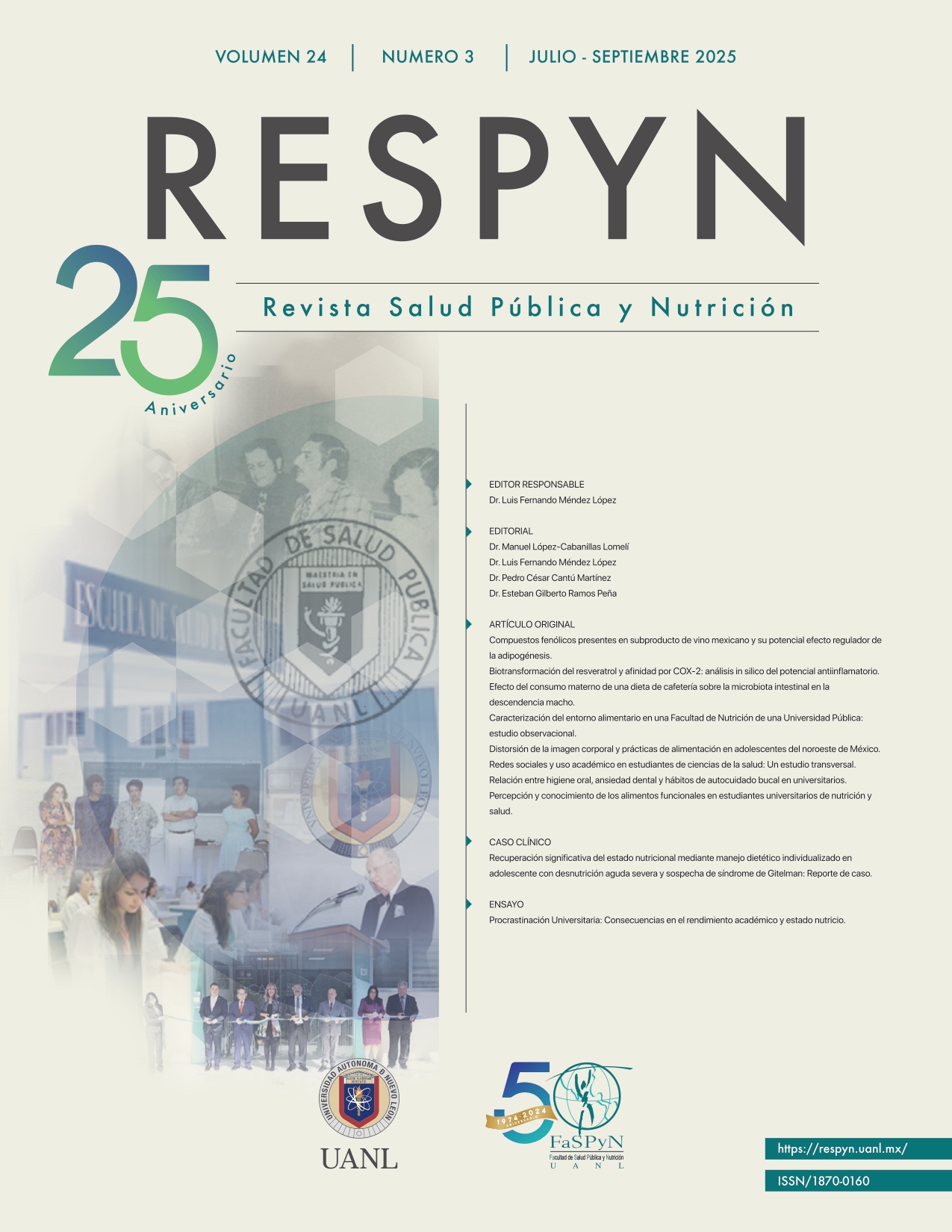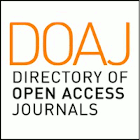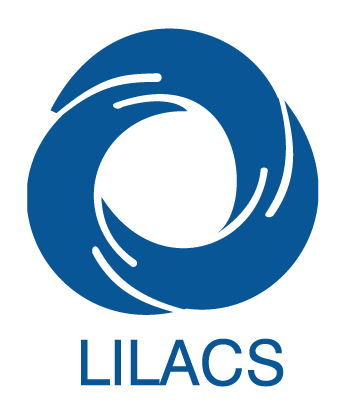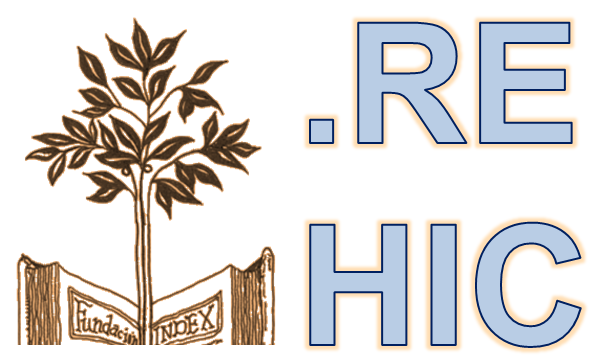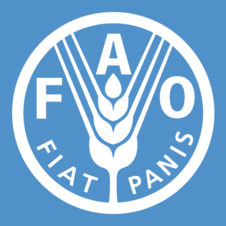Body image distortion and eating practices among adolescents in northwestern Mexico
DOI:
https://doi.org/10.29105/respyn24.3-874Keywords:
Distorsión de la Imagen Corporal, Alimentación, AdolescentesAbstract
Introduction: Body image distortion influences adolescents' eating practices, affecting not only what they consume but also how, when, where, and with whom they eat. Objective: To compare eating practices among adolescents with and without body image distortion from public secondary schools. Material and method: A cross-sectional study was conducted with 560 adolescents aged 13 to 15 years. Validated instruments were used to assess body image perception and eating practices. Data were analyzed using the Mann-Whitney U test with SPSS software. Results: A total of 47% of adolescents showed body image distortion. No statistically significant differences were found in the types of food consumed, except for a lower intake of soft drinks and juices in the group with body image distortion. Additionally, this group reported more frequent food consumption when invited by friends and a lower frequency of sharing dinner with siblings (p = 0.03). Conclusion: Body image distortion was associated with specific differences in eating practices. No significant variations were observed in the types of foods consumed. The findings highlight the importance of incorporating perceptual factors into strategies for promoting healthy eating among adolescents.
Downloads
References
Aparicio, P. F., Ortega, P. A., & Terrazas, M. A. (2018). Percepción de la imagen corporal en adolescentes de secundaria en Huitzilac. Inventio, 14(34), 17–23. https://doi.org/10.30973/inventio/2018.14.34/2 DOI: https://doi.org/10.30973/inventio/2018.14.34/2
Ben, H., Yaich, S., Ben, M., Ben, M., Trigui, M., Jedidi, J., et al. (2021). What are the correlates of body image distortion and dissatisfaction among school-adolescents? International Journal of Adolescent Medicine and Health, 33(5), 20180279. https://doi.org/10.1515/ijamh-2018-0279 DOI: https://doi.org/10.1515/ijamh-2018-0279
Castells-Cuixart, M., Capdevila, P., Girbau, S., & Rodríguez, C. (2006). Estudio del comportamiento alimentario en escolares de 11 a 13 años de Barcelona. Nutrición Hospitalaria, 21(4), 517–532. https://scielo.isciii.es/scielo.php?script=sci_arttext&pid=S0212-16112006000700010
Center for disease Control and Prevention (CDC) (2000). Percentiles de estatura por edad y peso por edad. Recuperado el 10 de febrero de 2018 de https://www.cdc.gov/growthcharts/
Chae, H. (2022). Factors associated with body image perception of adolescents. Acta Psychologica, 227, 103620. https://doi.org/10.1016/j.actpsy.2022.103620 DOI: https://doi.org/10.1016/j.actpsy.2022.103620
Colombo, A. B. M., Rodríguez, F. D., Garza, S. D. S., Chavarria, K. A. T., Rios, E. E. V., Villarreal, R. A. R., García-Hernandez, D. G., & Díaz, A. C. (2024). El impacto de la comida rápida en la población en Nuevo León: estudio parcial. Brazilian Journal of Health Review, 7(4), e71220. https://doi.org/10.34119/bjhrv7n4-064 DOI: https://doi.org/10.34119/bjhrv7n4-064
Coutiño, A. G., & Mendoza, W. A. (2023). Alimentación y estado de nutrición en niños escolares de zonas marginadas de Tuxtla Gutiérrez. Universidad de Ciencias y Artes de Chiapas. https://repositorio.unicach.mx/handle/20.500.12753/4960
Del Río, F. (2022). Prácticas alimentarias, un fenómeno multinivel. Revista Chilena de Nutrición, 49(2), 263–267. http://www.scielo.cl/scielo.php?script=sci_arttext&pid=S0717-75182022000200263 DOI: https://doi.org/10.4067/S0717-75182022000200263
García, E. A., Juárez, L., Sámano, R., Márquez, H., Martínez, D. L., Lamar, V. J., & Merino, B. (2021). Factores asociados a la distorsión de la imagen corporal en mujeres adolescentes. Revista de Salud Pública y Nutrición, 20(1), 12–19. https://doi.org/10.29105/respyn20.1-2
Gerbotto, M., & Paturzo, C. L. (2020). Hábitos alimentarios y percepción de la imagen corporal en un grupo de adolescentes que realizan comedia musical. DIAETA, 38(172), 26–40. https://www.scielo.org.ar/scielo.php?script=sci_arttext&pid=S1852-73372020000300026
Góngora, V. (2023). Actividades en redes sociales, insatisfacción corporal, ideales de belleza y apreciación corporal en mujeres adultas. Psychology, Society & Education, 15(2), 19-27. https://dx.doi.org/10.21071/psye.v15i2.15798 DOI: https://doi.org/10.21071/pse.v15i2.15798
Hidalgo, K. P., Tisalema, E. L., Freire, J. P., & Jácome, M. P. (2022). Sobrepeso y obesidad en los adolescentes. Vive Revista de Salud, 5(14), 619–625. https://doi.org/10.33996/revistavive.v5i14.174 DOI: https://doi.org/10.33996/revistavive.v5i14.174
Hosseini, S. A., & Padhy, R. K. (2025). Body image distortion (Archived). In StatPearls. StatPearls Publishing. https://europepmc.org/article/nbk/nbk546582
Jung, E. H., & Jun, M. K. (2022). Factors affecting body image distortion in adolescents. Children, 9(12), 1944. https://doi.org/10.3390/children9121944 DOI: https://doi.org/10.3390/children9121944
Kong, S. (2023). Cómo las preocupaciones sobre la imagen corporal según el género influyen en el consumo de bebidas azucaradas. Comunicación en Salud, 39 (6), 1218–1234. https://doi.org/10.1080/10410236.2023.2210378 DOI: https://doi.org/10.1080/10410236.2023.2210378
Kwon, S., Kim, R., Lee, J., Kim, J., Song, S., Kim, S., & Oh, H. (2022). Asociación del uso de teléfonos inteligentes con la distorsión de la imagen corporal y las conductas de pérdida de peso en adolescentes coreanos. JAMA Network Open, 5(5), e2213237. https://doi.org/10.1001/jamanetworkopen.2022.13237 DOI: https://doi.org/10.1001/jamanetworkopen.2022.13237
Linhares, I. S., Olivera, O., Ximenes, J., Ferraz, F., Pacheco, M., & Medeiros, M. (2024). Prevalence and factors associated with body image dissatisfaction among school students: National School Health Survey, 2019. Epidemiologia e Serviços de Saúde, 33, e20231441. https://doi.org/10.1590/S2237-96222024v33e20231441.en DOI: https://doi.org/10.1590/s2237-96222024v33e20231441.en
Meléndez, J. M., Cañez, G. M., & Frías, H. (2017). Comportamiento alimentario durante la adolescencia. ¿Nueva relación con la alimentación y el cuerpo? Revista Mexicana de Investigación en Psicología, 99–111. https://doi.org/10.32870/rmip.vi.546 DOI: https://doi.org/10.32870/rmip.vi.546
Meza, C., & Pompa, E. (2018). Body image distortion and dissatisfaction in a Mexican sample. Revista de Psicología y Ciencias del Comportamiento de la Unidad Académica de Ciencias Jurídicas y Sociales, 9(2), 120–131.
https://doi.org/10.29365/rpcc.20181207-75 DOI: https://doi.org/10.29365/rpcc.20181207-75
Nieto-Ortiz, D., & Nieto-Mendoza, I. (2020). Percepción de la imagen corporal en universitarias de la ciudad de Barranquilla, Colombia: un estudio descriptivo-transversal. Musas, 5(2), 77–92 . https://doi.org/10.1344/Musas2020.Vol5.Num2.5 DOI: https://doi.org/10.1344/musas2020.vol5.num2.5
Salas-González, M. D., Loria-Kohen, V., Jiménez-Ortega, A. I., & López-Sobaler, A. M. (2023). Factores nutricionales relacionados con la resistencia a la insulina en escolares y adolescentes. Nutrición Hospitalaria, 40(spe2), 51–54 . http://scielo.isciii.es/scielo.php?script=sci_arttext&pid=S0212-16112023000700013
Sen, B. (2006). Frequency of family dinner and adolescent body weight status: Evidence from the National Longitudinal Survey of Youth, 1997. Obesity, 14(12), 2266–2272. DOI: 10.1038/oby.2006.266 DOI: https://doi.org/10.1038/oby.2006.266
Shamah-Levy, T., Gaona-Pineda, E. B., Cuevas-Nasu, L., Morales-Ruan, C., Valenzuela-Bravo, D. G., Méndez-Gómez Humarán, I., et al. (2023). Prevalencias de sobrepeso y obesidad en población escolar y adolescente de México. Salud Pública de México, 65(Supl 1), S218–S224. https://doi.org/10.21149/14762 DOI: https://doi.org/10.21149/14762
Shamah-Levy, T., Gaona-Pineda, E. B., Cuevas-Nasu, L., Valenzuela-Bravo, D. G., Morales-Ruan, C., Rodríguez-Ramírez, S., et al. (2024). Sobrepeso y obesidad en población escolar y adolescente. Salud Pública de México, 66, 404–413. https://doi.org/10.21149/15842 DOI: https://doi.org/10.21149/15842
Silva, G. (2010). Gráficas de crecimiento- CDC. Recuperado el 10 de junio de 2018 de https://www.pedia-gess.com/index.php/crecimiento-desarrollo/130-graficas-crecimiento-cdc
Soto, M., Fernández, B., Aguinaga, I., Guillén-Grima, F., Serrano, I., Canga, N., Hermoso, J., Stock, C., Kraemer, A., & Annan, J. (2015). Análisis de la percepción de la imagen corporal que tienen los estudiantes universitarios de Navarra. Nutrición Hospitalaria, 31(5), 2269–2275. https://dx.doi.org/10.3305/nh.2015.31.5.7418
Urrutia-Medina, J., Vera-Sagredo, A., Flores-Rivera, C., Hetz-Rodriguez, K., Pavez-Adasme, G., & Poblete-Valderrama, F. (2023). Percepción de autoconcepto físico en estudiantes de enseñanza secundaria en clases de Educación Física. Retos, 49, 510–518. https://doi.org/10.47197/retos.v49.98769 DOI: https://doi.org/10.47197/retos.v49.98769
Wang, M. L., Peterson, K. E., Richmond, T. K., Spadano-Gasbarro, J., Greaney, M. L., Mezgebu, S., et al. (2013). Family physical activity and meal practices associated with disordered weight control behaviors in a multiethnic sample of middle-school youth. Academic Pediatrics, 13(4), 379–385. https://doi.org/10.1016/j.acap.2013.04.012 DOI: https://doi.org/10.1016/j.acap.2013.04.012
Yun, H. J., & Park, S. (2022). Factors affecting body image distortion in adolescents: Using data from the 16th (2020) Korea Youth Risk Behavior Survey. Journal of Convergence Culture Technology, 8(2), 139–148. https://doi.org/10.17703/JCCT.2022.8.2.139
Zeferino, B. M., García Villegas, E. A., Juárez Martínez, L., Sámano, R., Márquez González, H., Martínez Torres Pico, D. L., et al. (2021). Factores asociados a la distorsión de la imagen corporal en mujeres adolescentes. Revista de Salud Pública y Nutrición, 20(1), 12–19. https://doi.org/10.29105/respyn20.1-2 DOI: https://doi.org/10.29105/respyn20.1-2
Downloads
Published
How to Cite
Issue
Section
License
Copyright (c) 2025 María Natividad Ávila-Ortiz, Georgina Mayela Nuñez-Rocha, Ana Elisa Castro-Sánchez, Anahí Martínez-Rodríguez, Guillermo Cano-Verdugo, Karina Janett Hernández-Ruiz

This work is licensed under a Creative Commons Attribution 4.0 International License.
The rights of the work belong to the author or authors, however, by sending it for publication in the Public Health and Nutrition Magazine of the Faculty of Public Health and Nutrition of the Autonomous University of Nuevo León, they grant the right for its first publication in between electronic, and possibly, in print to the Public Health and Nutrition Magazine. The license used is the Creative Commons attribution, which allows third parties to use what is published whenever the authorship of the work is mentioned and the first publication that is in the Public Health and Nutrition Magazine. Likewise, the author or authors will take into account that it will not be allowed to send the publication to any other journal, regardless of the format. The authors will be able to make other independent and additional contractual agreements for the non-exclusive distribution of the version of the article published in the Public Health and Nutrition Magazine (e.g., institutional repository or publication in a book) provided they clearly state that The work was published for the first time in the Public Health Magazine, Magazine of the Faculty of Public Health and Nutrition of the Autonomous University of Nuevo León.
